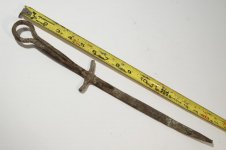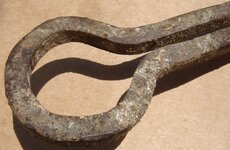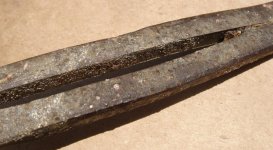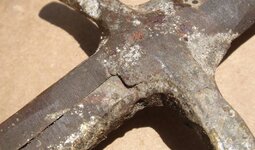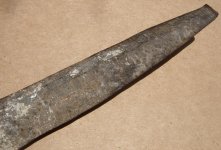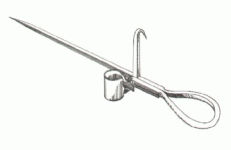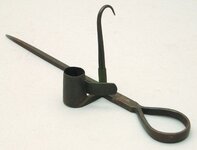scaupus
Hero Member
I found this item buried in the ground about 5" deep while metal detecting in my dad's yard. He had no idea it was there or where it came from - he's owned the home since 1977, it was built in 1925; before 1923 it was a tropical forest on the Miami Ridge about one mile south of the mouth of the Miami River (florida). Mary Brickell cleared the area, put in roads and electric street lighting in 1923 and gave the whole area, about a square mile, to the city of miami, calling it "Brickell Hammock" but it's been known as The Roads since the road grid does not match the rest of the city. The area was very lightly inhabited sporadically before the 1890's, panthers still roamed the ridge at that time. Before the 1890s there had been some Bahamians, a few squatters, Seminole Indians (2nd and to a lesser degree, the 3rd Seminole wars caused the population of Biscayne Shore as it was known then, to evacuate en mass), US Army was at Fort Dallas on the north shore of the Miami River; there were planters at various times; and on a few occasions, there were the Spanish going back to first discovery, from 1516 until 1744. I nicked the metal and it is gold colored under the "patina.", indicating to me it is probably bronze. It looks to me like bronze bar stock or brazing rods possibly. I wonder if the white patches are leached out lead. My dad thinks it predates the house. He's 88 and he owns a chopping knife that his grandfather smithed sometime before the turn of the 20th century, and he thinks someone similarly made this dagger using a fire, anvil, hammer, and grinder, motivated by the need for a weapon, rather than a later 20th century person making a project knife. Bronze can be worked at a lower temperature than steel, and is quite hard, but brittle compared to weapon steel. I should mention that the edges are sharp. I'm trying to learn more about the previous inhabitants, but all I know is that it wasn't made by the people who sold the house to my dad. The original owner was a woman who founded a garden club and planted the gardens around the house (which really interfere with my artifact hunting). I don't know yet if there were any other inhabitants. The blade is bent and the tip broken. There are grindstone or belt-sanding striations - I don't know which, though everywhere except the inside of the rods in the tang area. The thought occurred to me that it may have been made to keep aboard a boat -bronze would be corrosion resistant, and with the hole in the pommel area it could be hung on a hook for easy storage and quick access . The property is 1/4 mile from the bay. About 2 miles north is the Miami Circle. Inside the circle human vertabra from beheadings were found 12" deep. They haven't been dated yet, but obviously they are pretty old. So at 4-5" deep, this knife may date a century or more possibly.


